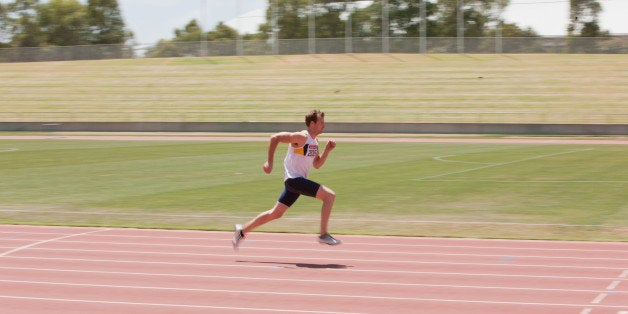
What do Lance Armstrong, Peyton Manning, Adrian Peterson, Tiger Woods, Michael Phelps and Bartolo Colon have in common? They've all allegedly had their blood composition modified, in ways legal or not.
There is a long list of banned substances that every professional athlete -- from Olympians to Super Bowlers -- is required to stay away from during their career performances, but not everyone is aware of the many enhancing procedures availed to them that haven't made the list... thus far.
We are quite aware of how Lance Armstrong duped everyone by keeping secret his erythropoietin (EPO) treatments, a blood hormone normally produced by the kidneys that improves oxygen transport through blood and into muscle.
EPO is commonly extracted, concentrated and injected for medical treatment in cases such as acute anemia, renal failure, cancer and HIV in order to benefit recovery. Once the correlation of improved oxygen from EPO and sport performance became clear to athletes, its use became intriguing to many, but soon put on the no-no list.
But many other medical advancements and devices are out there that more or less do the same thing, only in different ways, and they are legal. Athletes, because they can afford it, have these treatments at their fingertips at any time, unlike the common person. And they all have to do with the blood.
It's no secret, but not publicized, that many athletes use or even own their own hyperbaric chambers; Michael Phelps being one, and Tiger Woods another, who is building his own oxygen therapy room in his new home. These oxygen-enhancing machines have been around for decades, popularized by deep-sea divers needing to avoid the 'bends.' The chamber's main function is to increase the concentration of oxygen in the bloodstream. By increased pressure, oxygen is forced into the blood. Just like EPO, it has long been used in hospitals for oxygen-deprived brain injury, and accelerating wound healing. To many without injury, now it's a way of life just to feel energized. Hyperbaric not only helps wounds heal, the oxygen flows through the entire system, and the infusion of oxygen helps the body produce more red blood cells; it also simulates the effect of being in an extremely high altitude, for those players about to play in cities such as Denver. An added bonus...hyperbaric increases natural stem cell production.
Hyperbaric has not been kept a secret in the sports community; athletes are able to increase oxygen in the blood before an event to create muscle energy, and then able to repair from stress or trauma after. Any athlete has the wherewithal to have a hyperbaric session before an event. So, has the oxygen or performance level ever been checked between those who do hyperbaric before the game, and those who don't? So far, there is no documentation. But wait... hyperbaric goes beyond athletes -- they're now used for racehorses. Are you betting on the right horse? It's not just statistics that need to be researched before a race.
Now come stem cells. Injured athletes right and left are running to stem cells as an adjunct treatment along with any for injuries they suffer. As we see how the NFL prize quarterback Peyton Manning, at age 36, has miraculously recovered from his serious neck injury, no one can doubt the effects of stem cell therapy.
Dr. James Andrews is a prominent sports orthopedic surgeon who now includes adult stem cell therapy in his practice -- Adrian Peterson and RGIII being two of his patients. He believes stem cell therapy "will be a transformational event." He does not name names, and wishes to be quiet about it. "We don't advertise it, and we don't want to sensationalize it," he says.
Did you know that stem cells are very smart and calculating individuals? The cells coming from one's own body (adipose from fat, and mesenchymal from bone marrow, cord blood, peripheral blood) directed to the site of injury can induce healing, but the abundance of applied stem cells leaves many free to migrate, looking for repair of any other area in need. A large amount of stray stem cells can therapeutically give new life to any part of the body, and therefore becomes a preventive tool for halting disease before it progresses; it can be regenerative as well as rejuvenating, and now is considered to be an anti-aging property.
The word is out about stem cell regenerative therapy, and people throughout the country with the means to have it, are getting stem cell therapy just for preventive and anti-aging measures. It doesn't take an injury any more to be lured to stem cell therapy. The aging athlete can thus compete with the twenty-year-old, and this rejuvenation process is legal.
So what can be expected if half the players have the preventive stem cell treatment no matter what injury or age, and the other half do not? Are they able to evaluate the difference?
Bartolo Colon, professional baseball pitcher and Cy Young award winner, at the age of 37 in 2010, had fat and bone marrow stem cells injected into his elbow and shoulder because of ligament damage and a torn rotator cuff which were seen as career-ending injuries. The stem cell therapy subsequently renewed his career; but he was soon suspended for 50 games when his above-normal testosterone level was discovered.
It is relevant that as one gets older, testosterone levels decline. But the administration of testosterone is known to increase energy and stamina, build muscle mass and strength, and improve concentration. The therapeutic use of testosterone for older men throughout society is becoming more and more popular as its viability has become documented (mainly with bio-identical treatment), according to Dr. Abe Morgentaler, Harvard Medical School. There is no question it's a violation to the rules because of it being on the list of banned substances, but is the replenishment of testosterone to this athlete (who is almost twice the age of many fellow players) really a violation of playing on a level basis? Maybe testosterone levels should be checked before every game, and have every player's score fall within a certain range.
The testosterone advantage/disadvantage could be equated to yet another popular therapeutic device -- the altitude training tent. In the past, and, often still today, athletes coming from other cities were at a disadvantage playing in Denver, where the local players were already acclimated to the high altitude level. Now it seems to be legal to house athletes in these enclosures in order to bring them in par with the opposing team. Now they can play on an equal playing field.
But to take it further, these tents are currently being utilized by athletes, whether they are to play in a higher altitude or not, just to benefit by the oxygen enhancement induced by these devices, therefore giving those who use them a possible advantage when playing on their own turf.
And to come back to Lance and EPO injections, these oxygen-enriched enclosures are actually increasing the production of the erythropoietin hormone. As noted previously, EPO increases red blood cell production, thus increasing muscle utilization and energy. Another supplemental advantage?
Enhanced External Counterpulsation (EECP) is yet another therapy that boosts oxygen through the blood, enhancing athletic performance by contributing to a lower lactic acid buildup through increased nitric oxide; the effect being similar to an endurance training session. This therapy was initially conceived for heart patients, and is actually FDA and Medicare approved.
An EECP machine has been and can be an integral part of an athlete's workout room, alongside the hyperbaric chamber. Shaquille O'Neil is known to use one. Cuffs are strapped to the legs, and heart sensors are attached to a monitor that follows the heartbeat. With every beat, pressure is applied to the legs, moving the blood to the heart, and increasing the blood flow. Its pressure contributes to the expansion of arteries, and increases oxygen-rich blood flow to the heart. This improves exercise tolerance, yet creating another way of energizing the system. Is this unfair advantage?
All of these techniques are pervasive throughout sports, even the Olympics. These few athletes named here are just the tip of the iceberg; think of entire teams implementing these devices... because many do.
The sports profession seems to be primed for the spawning of stem cell therapy in America as they have the money to expend on such treatments, and as the word gets out that anyone can have this, whether injured or not. Put this together with a hyperbaric chamber, an EECP machine, housed in an oxygen-enriched workout room, and you've got one energized athlete. And yet, how can such therapies be legally justified as some players take on certain therapies and some do not? Can it ever be equal?
